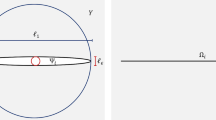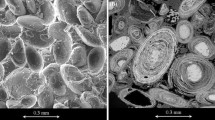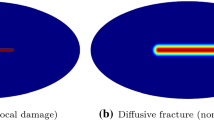Abstract
A mathematical model and a procedure of solving problems for the development of functionally gradient porous materials ensuring the desired distribution of stress-strain state parameters over the volume of the structure under explosion and impact loadings are proposed. The choice of the model is based on general theoretical concepts and is validated by comparison of the calculated results with experimental data.
Similar content being viewed by others
Abbreviations
- v i :
-
velocity-vector components
- S ij :
-
stress-deviator components
- E :
-
specific internal energy
- ɛ ij :
-
strain-rate-deviator components
- σ ij :
-
stress-tensor components
- δ ij :
-
Kronecker delta
- D/Dt :
-
Jaumann derivative
- e ij :
-
strain-rate-tensor components
- μ:
-
shear modulus
- σ:
-
yield stress
- f :
-
porosity parameter
- d s , η:
-
material constants
- V s :
-
specific volume of a matrix
- V p ,V :
-
specific volume of pores and a porous medium, respectively
- P s :
-
pressure in a matrix
- σ s , μ s :
-
yield stress and shear modulus of a matrix
- Φ:
-
porosity
- ɛ p ij :
-
plastic-strain-tensor components
- x :
-
relative volume (compressibility)
- ɛp :
-
equivalent plastic strain
- α1,n 1,b, h :
-
material constants
- T m ,T m0 :
-
melting temperature under loading and under normal conditions, respectively
- ρ0 :
-
initial density
- V 0 :
-
initial specific volume of an alloy
- α n :
-
weight fraction of thenth component
- V 0n :
-
specific volume of thenth component
- γ 0 :
-
Grüneisen function
- K s :
-
isothermal modulus in compression
- β:
-
thermal-expansion coefficient
- C v :
-
thermal capacity at constant volume
- ρ1 :
-
density atT=0 K
- m :
-
parameter of interatomic interaction
- E 0 :
-
initial specific energy of thermal vibrations
- f * :
-
limiting value off
- ɛ p * :
-
limiting value of ɛp
- W 0 :
-
impact velocity
- ɛ0 :
-
specific internal energy atT=0 K
References
R. A. Krektuleva, “Transformation of plane shock waves in gradient media,” inMechanics of a Deformable Solid Body [in Russian], Tomsk University Publishers, Tomsk (1992), pp. 35–40.
A. V. Gerasimov and R. A. Krektuleva, “Certain results of numerical experiments on the propagation of shock waves in materials with the gradient distribution of physicomechanical properties,” in:Detonation. Chemical Physics of Combustion and Explosion Processes (Proc. X Symp. on Combustion and Explosion) [in Russian], Chernogolovka (1992), pp. 137–138.
R. A. Krektuleva and A. V. Gerasimov, “Propagation of a shock pulse in condensed gradient media,” in:Numerical Solution Methods for Problems of the Elasticity and Plasticity Theories (Proc. XIII Interrepublican Conf.) [in Russian], Novosibirsk (1995), pp. 104–108.
M. L. Wilkins, “Calculation of elastoplastic flows,” in:Fundamental Methods in Hydrodynamics [Russian translation], Mir, Moscow (1967), pp. 212–263.
K. P. Stanyukovich (ed.),Physics of Explosion [in Russian], Nauka, Moscow (1975).
J. N. Johnson, “Dynamic fracture and spallation in ductile solid,”J. Appl. Phys.,52, No. 4, 2812–2825 (1981).
D. J. Streinberg, S. G. Cochran, and M. W. Guinan, “A constitutive model for metals applicable at high-rate strain,”J. Appl. Phys.,51, No. 3, 1496–1504 (1980).
M. L. Wilkins, “Modelling the behaviour of materials,” in:Structural Impact and Crashworthiness (Proc. Int. Conf.),2, 243–277 (1984).
R. A. Krektuleva and T. M. Platova, “Simulation of the behavior of multicomponent materials in shock waves,” in:Detonation (Proc. II All-Union Conf. on Detonation, Chernogolovka) [in Russian],2, 98–101 (1991).
R. Kinslow (ed.),High-Velocity Impact Phenomena, Academic Press, New York-London (1970).
K. N. Kreyenhagen, M. H. Wagner, J. J. Piechocki, and R. L. Bjork, “Ballistic limit determination in impacts on multimaterial laminated targets,”AIAA J.,8, No. 12, 2147–2151 (1970).
G. I. Kanel and S. V. Razorenov,Shock Wave Loading of Metals. Motion of Specimen, Surface [in Russian], Preprint, Institute of Chemical Physics, Academy of Sciences of the USSR (1989).
Additional information
Research Institute of Applied Mathematics and Mechanics, Tomsk University, Tomsk, Russia. Translated from Problemy Prochnosti, No. 2, pp. 139–150, March–April, 1999.
Rights and permissions
About this article
Cite this article
Gerasimov, A.V., Krektuleva, R.A. Deformation and fracture model for a multicomponent elastoplastic porous medium with continuous variation of physicomechanical characteristics. Strength Mater 31, 210–218 (1999). https://doi.org/10.1007/BF02511111
Received:
Issue Date:
DOI: https://doi.org/10.1007/BF02511111




